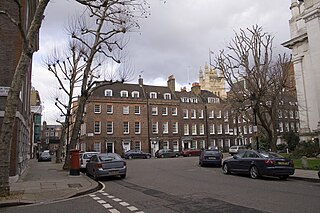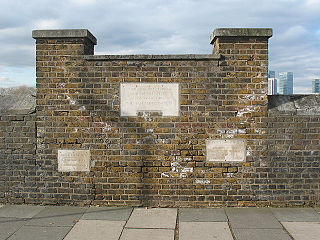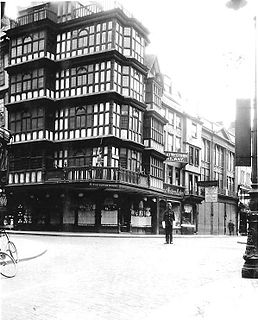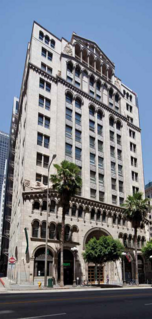
Imperial Chemical Industries (ICI) was a British chemical company. It was, for much of its history, the largest manufacturer in Britain. It was formed by the merger of four leading British chemical companies in 1926. Its headquarters were at Millbank in London. ICI was a constituent of the FT 30 and later the FTSE 100 indices.
Millbank is an area of central London in the City of Westminster. Millbank is located by the River Thames, east of Pimlico and south of Westminster. Millbank is known as the location of major government offices, Burberry headquarters, the Millbank Tower and prominent art institutions such as Tate Britain and the Chelsea College of Art and Design.

Smith Square is a square in Westminster, London, 250 metres south-southwest of the Palace of Westminster. Most of its garden interior is filled by St John's, Smith Square, a Baroque surplus church, which has inside converted to a concert hall. Most adjoining buildings are offices, with the focus on organisations lobbying or serving the government. In the mid-20th century, the square hosted the headquarters of the two largest parties of British politics, and it is now hosts much of the Department for Environment, Food and Rural Affairs and the Local Government Association. It has a pedestrian or mixed approach to the four sides and another approach to the north.

In classical architecture, a giant order, also known as colossal order, is an order whose columns or pilasters span two storeys. At the same time, smaller orders may feature in arcades or window and door framings within the storeys that are embraced by the giant order.

Thames House is an office building in Millbank, London, on the north bank of the River Thames adjacent to Lambeth Bridge. Originally used as offices by Imperial Chemical Industries (ICI), it has served as the headquarters of the United Kingdom's internal Security Service since December 1994. It also served as the London headquarters of the Northern Ireland Office (NIO) until March 2013.
Canadian Industries Limited, also known as C-I-L, is a Canadian chemicals manufacturer. Products include paints, fertilizers and pesticides, and explosives. It was formed in 1910 by the merger of five Canadian explosives companies. It was until recently a subsidiary of Imperial Chemical Industries until ICI was purchased by AkzoNobel.

The 1928 Thames flood was a disastrous flood of the River Thames that affected much of riverside London on 7 January 1928, as well as places further downriver. Fourteen people died and thousands were made homeless when floodwaters poured over the top of the Thames Embankment and part of the Chelsea Embankment collapsed. It was the last major flood to affect central London, and, along with the disastrous North Sea flood of 1953, helped lead to the implementation of new flood control measures that culminated in the construction of the Thames Barrier in the 1970s.

The Union Building is a building on the Bund in Shanghai, China. It is located at No. 3, the Bund.

Charles Sargeant Jagger was a British sculptor who, following active service in the First World War, sculpted many works on the theme of war. He is best known for his war memorials, especially the Royal Artillery Memorial at Hyde Park Corner and the Great Western Railway War Memorial in Paddington Railway Station. He also designed several other monuments around Britain and other parts of the world.

Horseferry Road is a street in the City of Westminster in central London running between Millbank and Greycoat Place. It is perhaps best known as the site of City of Westminster Magistrates' Court. The ubiquity of the Magistrates' Court in newspaper crime reports means that the road name has wide recognition in the UK. Other notable institutions which are or have been located on Horseferry Road include Broadwood and Sons, the Gas Light and Coke Company, British Standards Institution, the Royal College of Veterinary Surgeons, the Burberry Group, the Environment Agency headquarters in Horseferry House, the National Probation Service, the Department for Transport and Channel 4. The Marsham Street Home Office building backs on to this road.

The Dutch House was a large timber-framed building situated at Nos 1 and 2, High Street Bristol, England. It was a well-known local landmark until its destruction in 1940.

The landmark Fine Arts Building is located at 811 West 7th Street in Downtown Los Angeles, California. Also known as the Global Marine House, it was declared a historic cultural monument in 1974.

10 Trinity Square is a Grade II* listed building in London, United Kingdom, overlooking the River Thames at Tower Hill, in the southeastern corner of the City of London. Built in the Beaux Arts style, it is best known as the former headquarters of the Port of London Authority and is thus also sometimes referred to as the Port of London Authority Building.

Leigh Town Hall is a municipal building in Leigh, Greater Manchester, England. It stands in Civic Square at the junction with Market Street, facing Leigh parish church. It was built in 1907 and granted grade II listed building status in 1987.

The Queen Alexandra Military Hospital (QAMH) opened in July 1905. It was constructed immediately to the north of the Tate Britain adjacent to the River Thames on the borders of the neighbourhoods of Millbank and Pimlico, Westminster, London. The hospital closed in 1977, but several buildings remain.

National Hotel is a heritage-listed hotel at 35 Grafton Street, Warwick, Southern Downs Region, Queensland, Australia. It was designed by James Marks and Son built in 1907 by Daniel Connolly. It is also known as Allman's Hotel. It was added to the Queensland Heritage Register on 21 October 1992.

Silvertown War Memorial, also known as Silvertown Explosion Memorial, is a war memorial in Silvertown, in East London. It serves as a memorial for the workers at the Brunner Mond chemical plant who were killed on active service during the First and Second World Wars, while also commemorating the people killed in the Silvertown explosion on 17 January 1917. It became a Grade II listed building in 1999.

George's Dock Building is a Grade II listed building in Liverpool, England. It is located at the Pier Head on the city's waterfront. It is part of Liverpool's former UNESCO designated World Heritage Maritime Mercantile City. It was built in the 1930s in the Art Deco style, to the designs of architect Herbert Rowse. Occupants of the office space include, Merseytravel, The Liverpool City Region Combined Authority, Mersey Tunnels staff and The Mersey Tunnels Police. It also houses ventilation machinery for the Queensway Tunnel and the Mersey Tunnels Tour Offices.

Africa House is a Category B listed building in North Ayrshire, Scotland. It was designed by James Miller, or his son George, for the 1938 Empire Exhibition in Glasgow. It was originally a temporary structure built to house an exhibit of South African goods but after the exhibition was purchased by ICI Nobel. The company transported the structure to their explosives manufacturing plant in Ardeer, North Ayrshire. The structure was re-erected, though some decorative features were omitted, and, as Africa House, served as a kitchen and canteen for the company's staff. A two-storey concrete-framed extension was added to the structure in the 1960s.

Chiswick Mall is a waterfront street on the north bank of the river Thames in the oldest part of Chiswick in West London, with a row of large houses from the Georgian and Victorian eras overlooking the street on the north side, and their gardens on the other side of the street beside the river and Chiswick Eyot.

























